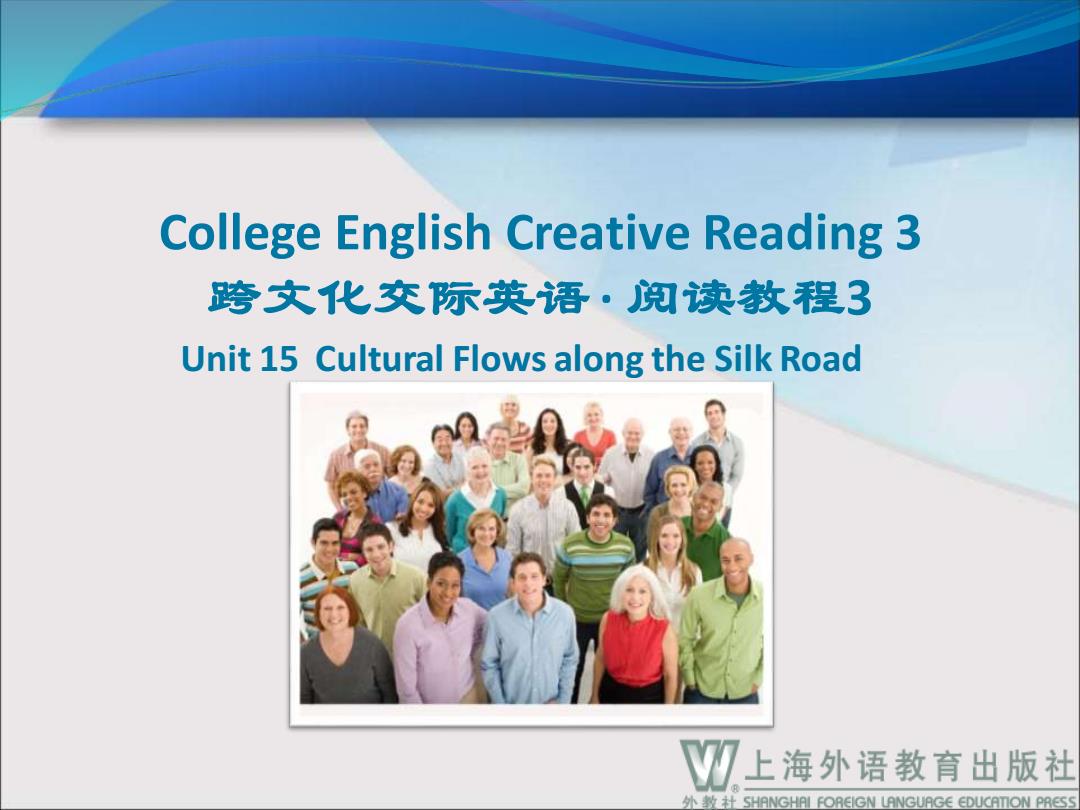
College English Creative Reading 3 跨文化交际英语·阅读教程3 Unit 15 Cultural Flows along the Silk Road 上海外语教育出版社 外数杜SHANGHAI FOREIGN LANGUAGE∈DUCATION PRESS
College English Creative Reading 3 跨文化交际英语 · 阅读教程3 Unit 15 Cultural Flows along the Silk Road

Note On The Topic Before You Read Reading Further Information Gain a full understanding of seven myths about the ancient Silk Road; Learn logical links in texts such as cause and effect and comparison and contrast; Develop your creative skills through a group discussion about the future of the Silk Road region
Before You Read Reading Further information Further Information Gain a full understanding of seven myths about the ancient Silk Road; Develop your creative skills through a group discussion about the future of the Silk Road region. Note On The Topic Learn logical links in texts such as cause and effect and comparison and contrast;
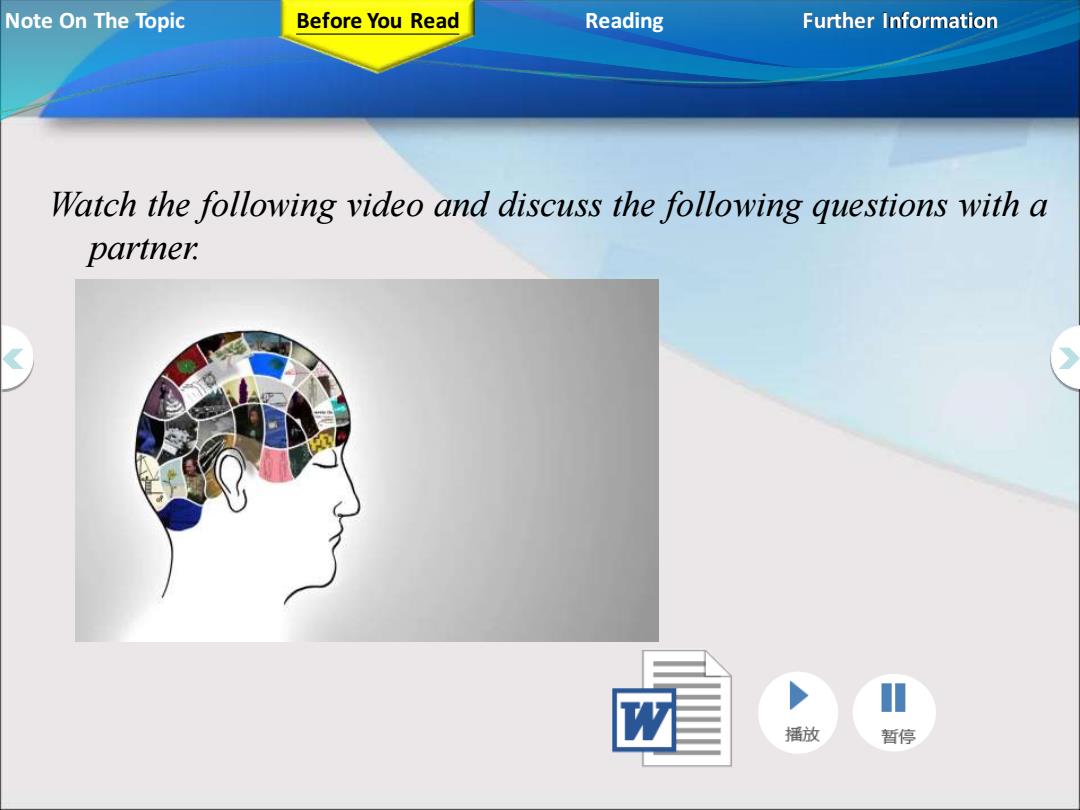
Note On The Topic Before You Read Reading Further Information Watch the following video and discuss the following questions with a partner 小 播放 暂停
Watch the following video and discuss the following questions with a partner. Note On The Topic Before You Read Reading Further information Further Information
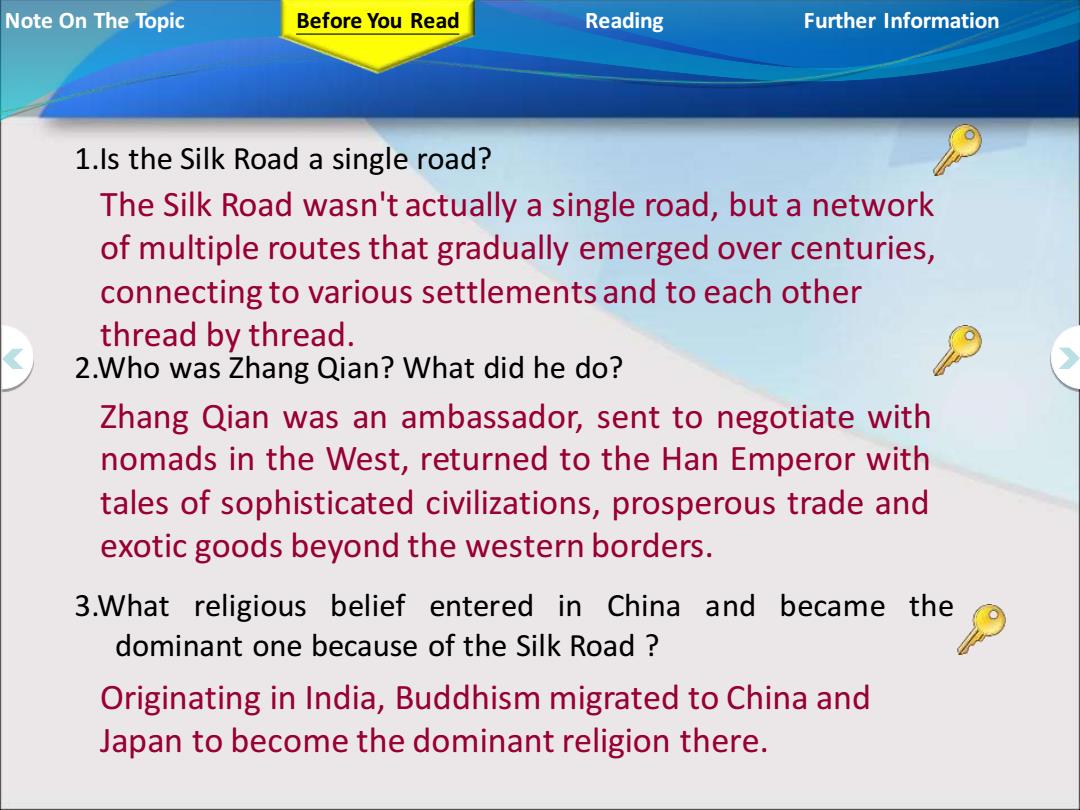
Note On The Topic Before You Read Reading Further Information 1.Is the Silk Road a single road? The Silk Road wasn't actually a single road,but a network of multiple routes that gradually emerged over centuries, connecting to various settlements and to each other thread by thread. 2.Who was Zhang Qian?What did he do? Zhang Qian was an ambassador,sent to negotiate with nomads in the West,returned to the Han Emperor with tales of sophisticated civilizations,prosperous trade and exotic goods beyond the western borders. 3.What religious belief entered in China and became the dominant one because of the Silk Road Originating in India,Buddhism migrated to China and Japan to become the dominant religion there
1.Is the Silk Road a single road? 2.Who was Zhang Qian? What did he do? 3.What religious belief entered in China and became the dominant one because of the Silk Road ? Zhang Qian was an ambassador, sent to negotiate with nomads in the West, returned to the Han Emperor with tales of sophisticated civilizations, prosperous trade and exotic goods beyond the western borders. Note On The Topic Before You Read Reading Further Information The Silk Road wasn't actually a single road, but a network of multiple routes that gradually emerged over centuries, connecting to various settlements and to each other thread by thread. Originating in India, Buddhism migrated to China and Japan to become the dominant religion there
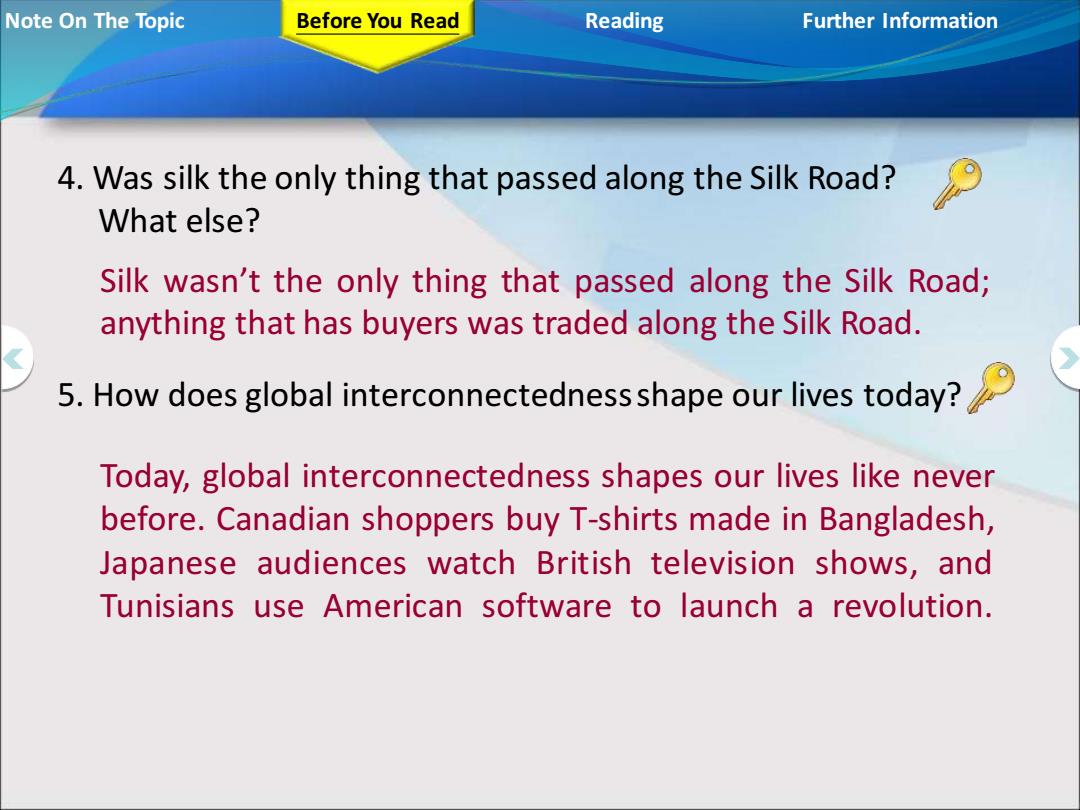
Note On The Topic Before You Read Reading Further Information 4.Was silk the only thing that passed along the Silk Road? What else? Silk wasn't the only thing that passed along the Silk Road; anything that has buyers was traded along the Silk Road. 5.How does global interconnectedness shape our lives today? Today,global interconnectedness shapes our lives like never before.Canadian shoppers buy T-shirts made in Bangladesh, Japanese audiences watch British television shows,and Tunisians use American software to launch a revolution
4. Was silk the only thing that passed along the Silk Road? What else? 5. How does global interconnectedness shape our lives today? Silk wasn’t the only thing that passed along the Silk Road; anything that has buyers was traded along the Silk Road. Today, global interconnectedness shapes our lives like never before. Canadian shoppers buy T-shirts made in Bangladesh, Japanese audiences watch British television shows, and Tunisians use American software to launch a revolution. Note On The Topic Before You Read Reading Further Information
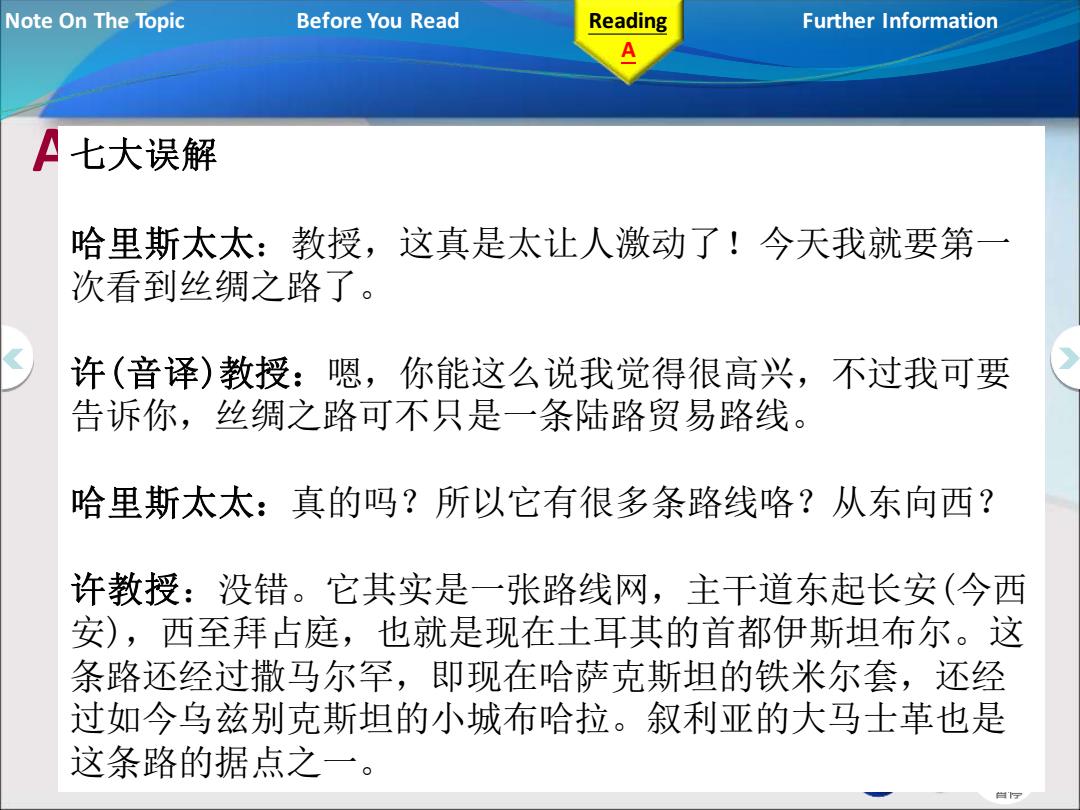
Note On The Topic Before You Read Reading Further Information 七大误解 哈里斯太太:教授,这真是太让人激动了!今天我就要第一 次看到丝绸之路了。 许(音译)教授:嗯,你能这么说我觉得很高兴,不过我可要 告诉你,丝绸之路可不只是一条陆路贸易路线。 哈里斯太太:真的吗?所以它有很多条路线咯?从东向西? 许教授:没错。它其实是一张路线网,主干道东起长安(今西 安),西至拜占庭,也就是现在土耳其的首都伊斯坦布尔。这 条路还经过撒马尔罕,即现在哈萨克斯坦的铁米尔套,还经 过如今乌兹别克斯坦的小城布哈拉。叙利亚的大马士革也是 这条路的据点之一
Seven Myths Mrs Harris: Professor, this is so exciting! Today will be my first time to see the Silk Road. Professor Xu: Well, I’m so happy to hear that you’re excited but I should tell you that the Silk Road was never just a single overland trading route. Mrs Harris: Really? So it’s really a number of routes, is it? Going east to west? Professor Xu: That's right. It's actually a network of routes, with a major one going westward between Chang’an (Xi’an) and Byzantium, which was the Turkish capital we now call Istanbul. Also included on this route were Samarkand, now known as Temirtau, in Kazakhstan and Bukhara, a town in present-day Uzbekistan. The route also took in Damascus in Syria. Reading A Note On The Topic Before You Read A Further Information 七大误解 哈里斯太太:教授,这真是太让人激动了!今天我就要第一 次看到丝绸之路了。 许(音译)教授:嗯,你能这么说我觉得很高兴,不过我可要 告诉你,丝绸之路可不只是一条陆路贸易路线。 哈里斯太太:真的吗?所以它有很多条路线咯?从东向西? 许教授:没错。它其实是一张路线网,主干道东起长安(今西 安),西至拜占庭,也就是现在土耳其的首都伊斯坦布尔。这 条路还经过撒马尔罕,即现在哈萨克斯坦的铁米尔套,还经 过如今乌兹别克斯坦的小城布哈拉。叙利亚的大马士革也是 这条路的据点之一
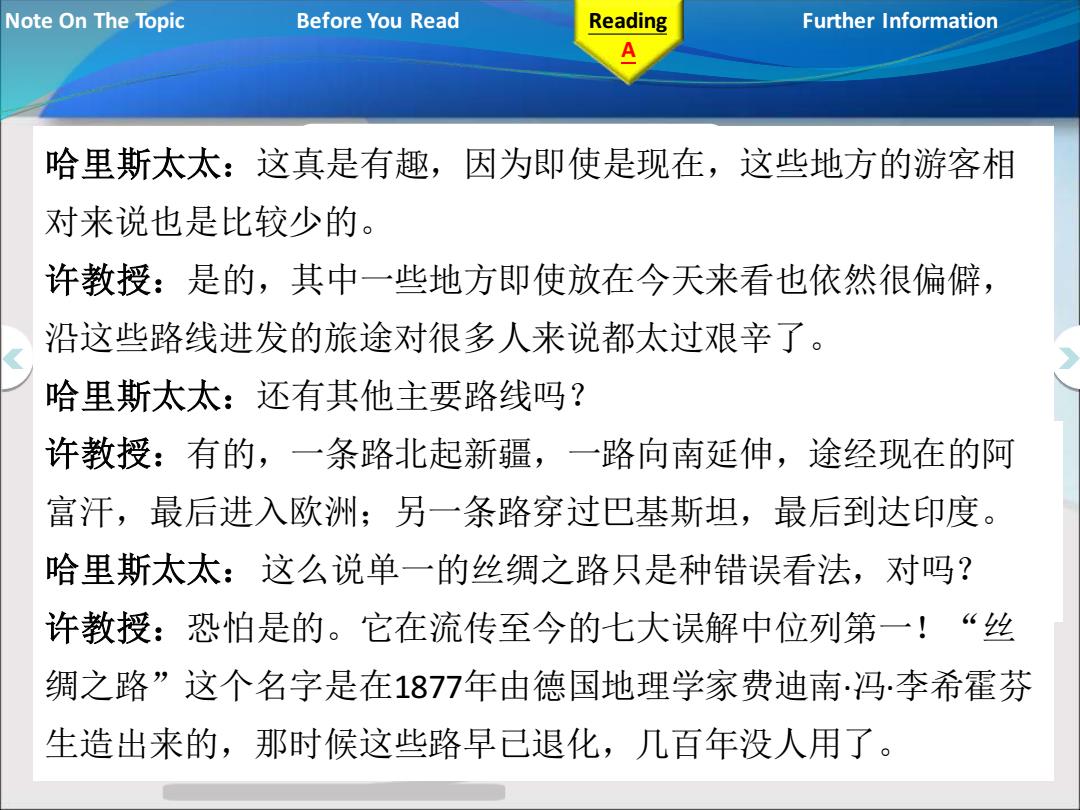
Note On The Topic Before You Read Reading Further Information 哈里斯太太:这真是有趣, 因为即使是现在,这些地方的游客相 对来说也是比较少的。 许教授:是的,其中一些地方即使放在今天来看也依然很偏僻, 沿这些路线进发的旅途对很多人来说都太过艰辛了。 哈里斯太太:还有其他主要路线吗? 许教授:有的,一条路北起新疆,一路向南延伸,途经现在的阿 富汗,最后进入欧洲;另一条路穿过巴基斯坦,最后到达印度。 哈里斯太太:这么说单一的丝绸之路只是种错误看法,对吗? 许教授:恐怕是的。它在流传至今的七大误解中位列第一!“丝 绸之路”这个名字是在1877年由德国地理学家费迪南·冯李希霍芬 生造出来的,那时候这些路早已退化,几百年没人用了
Mrs Harris: That’s interesting because even today those places get relatively few visitors. Professor Xu: Yes, some of these places are even now and the journey along these routes may be too for a lot of people. Mrs Harris: Were there any other major routes? Professor Xu: Yes , one went southward from Xin jiang through present-day Afghanistan into Europe, and another into Pakistan and finally to India. Mrs Harris: So the idea of a single Silk Road is just a myth, is it? Professor Xu: I ’m afraid so . The first of seven rather persistent myths! The name, Silk Road, was coined in 1877, by the German geographer who used the term many centuries after the routes had and fallen into disuse. Ferdinand von Richthofen, remote extremely difficult and involving a lot of effort to become worse arduous deteriorate far away in distance or space Reading A Note On The Topic Before You Read Further Information Ferdinand von Richthofen (1833–1905) was a German geographer, explorer, and scientist who invented the term “Silk Road” in 1877 having explored Central Asia in the 1870s. 哈里斯太太:这真是有趣,因为即使是现在,这些地方的游客相 对来说也是比较少的。 许教授:是的,其中一些地方即使放在今天来看也依然很偏僻, 沿这些路线进发的旅途对很多人来说都太过艰辛了。 哈里斯太太:还有其他主要路线吗? 许教授:有的,一条路北起新疆,一路向南延伸,途经现在的阿 富汗,最后进入欧洲;另一条路穿过巴基斯坦,最后到达印度。 哈里斯太太:这么说单一的丝绸之路只是种错误看法,对吗? 许教授:恐怕是的。它在流传至今的七大误解中位列第一!“丝 绸之路”这个名字是在1877年由德国地理学家费迪南·冯·李希霍芬 生造出来的,那时候这些路早已退化,几百年没人用了
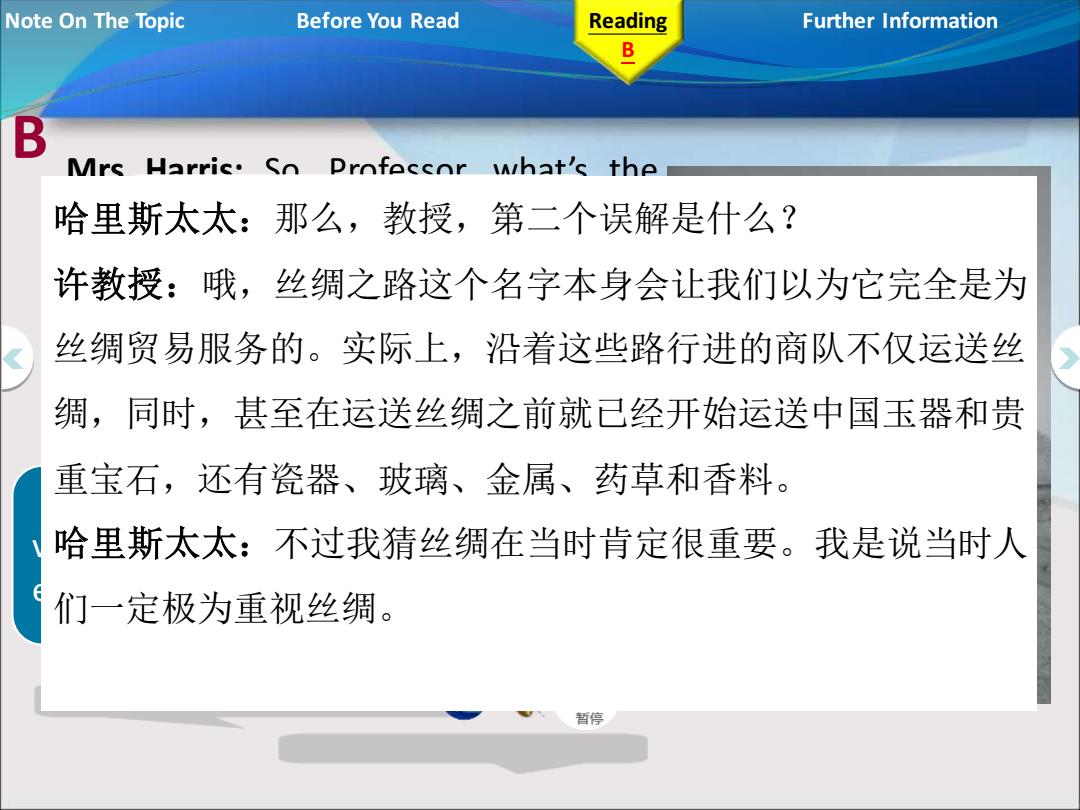
Note On The Topic Before You Read Reading Further Information B Mrs Harris.So Professor what's the 哈里斯太太:那么,教授,第二个误解是什么? 许教授:哦,丝绸之路这个名字本身会让我们以为它完全是为 丝绸贸易服务的。实际上,沿着这些路行进的商队不仅运送丝 绸,同时,甚至在运送丝绸之前就己经开始运送中国玉器和贵 重宝石,还有瓷器、玻璃、金属、药草和香料。 哈里斯太太:不过我猜丝绸在当时肯定很重要。我是说当时人 们一定极为重视丝绸。 暂停
Mrs Harris: So, Professor, what’s the second myth? Professor Xu: Well, the name itself makes us think that the Silk Road routes were entirely the silk trade. In fact, the along these routes not only carried silk but also, even before silk, Chinese jade and stones, as well as porcelain, glass, metals, and herbs and spices. Mrs Harris: But I guess silk must have been important. I mean it must have been held in high regard. priceless dedicated to a group of people and vehicles travelling together especially in a desert caravans to spend your time and effort doing something Reading B Note On The Topic Before You Read B Further Information extremely valuable and impossible to replace 哈里斯太太:那么,教授,第二个误解是什么? 许教授:哦,丝绸之路这个名字本身会让我们以为它完全是为 丝绸贸易服务的。实际上,沿着这些路行进的商队不仅运送丝 绸,同时,甚至在运送丝绸之前就已经开始运送中国玉器和贵 重宝石,还有瓷器、玻璃、金属、药草和香料。 哈里斯太太:不过我猜丝绸在当时肯定很重要。我是说当时人 们一定极为重视丝绸
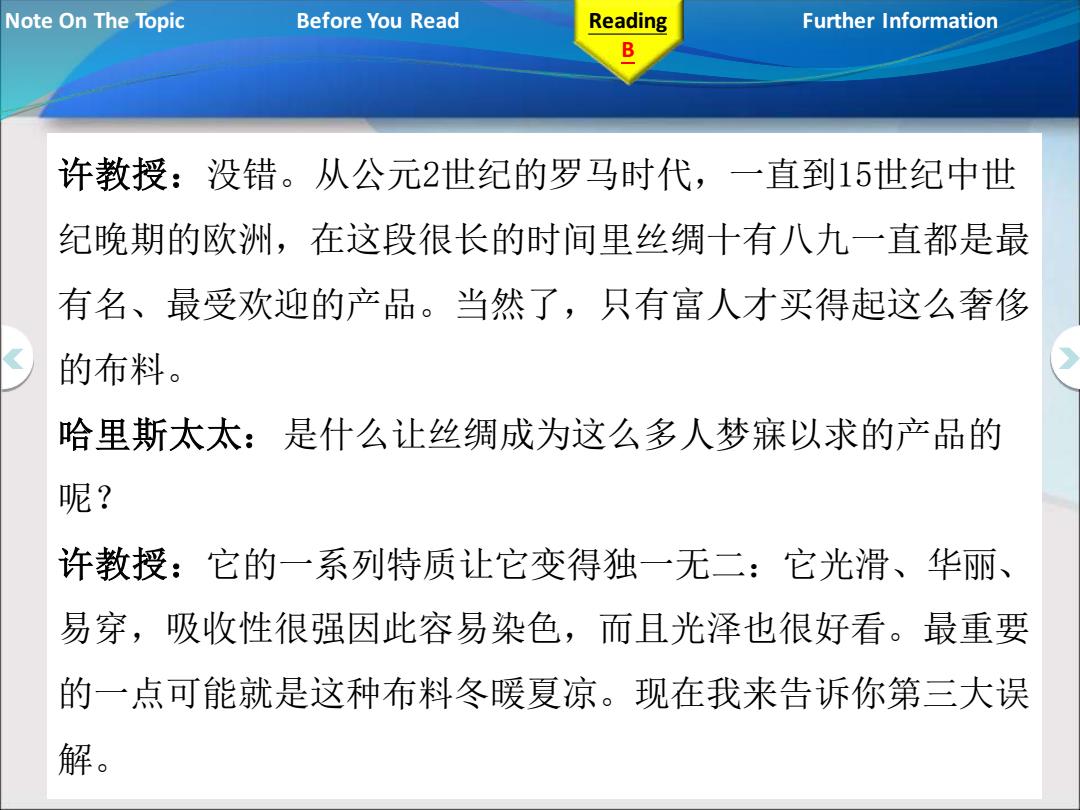
Note On The Topic Before You Read Reading Further Information B 许教授:没错。从公元2世纪的罗马时代,一直到15世纪中世 纪晚期的欧洲,在这段很长的时间里丝绸十有八九一直都是最 有名、最受欢迎的产品。当然了,只有富人才买得起这么奢侈 的布料。 哈里斯太太:是什么让丝绸成为这么多人梦寐以求的产品的 呢? 许教授:它的一系列特质让它变得独一无二:它光滑、华丽、 易穿,吸收性很强因此容易染色,而且光泽也很好看。最重要 的一点可能就是这种布料冬暖夏凉。现在我来告诉你第三大误 解
Professor Xu: That’s right. Silk was in all likelihood the most famous and product for a very long time — from second century Roman times right into late medieval Europe in the fifteenth century. Of course, only the affluent could afford such a luxurious fabric. Mrs Harris: What made silk so desirable to so many people? Professor Xu: It has a number of properties that make it unique: it is smooth and luxurious, easy to wear, highly and thus easy to dye, and it is also wonderfully . Most important of all perhaps is that the fabric is cool in summer and warm in winter. Now I’ll tell you the third myth. sought-after able to take in or hold a lot of something, especially liquid bright and shiny absorbent lustrous wanted by many people but not easy to get 许教授:没错。从公元2世纪的罗马时代,一直到15世纪中世 纪晚期的欧洲,在这段很长的时间里丝绸十有八九一直都是最 有名、最受欢迎的产品。当然了,只有富人才买得起这么奢侈 的布料。 哈里斯太太:是什么让丝绸成为这么多人梦寐以求的产品的 呢? 许教授:它的一系列特质让它变得独一无二:它光滑、华丽、 易穿,吸收性很强因此容易染色,而且光泽也很好看。最重要 的一点可能就是这种布料冬暖夏凉。现在我来告诉你第三大误 解。 Reading B Note On The Topic Before You Read Further Information

Note On The Topic Before You Read Reading Further Information 哈里斯太太:我想我能猜到那是什么。把丝绸和其他东西卖掉 之后,商人必定会带些中国所需要的货物回去。我说的对吗? 许教授:说得对,确实如此。大多数人只想到中国商品流入地 中海和欧洲国家,其实这种贸易流通是互惠的,蜂蜜、羊毛、 皮草之类的欧洲货也沿着丝绸之路来到了中国。因此贸易很大 程度上是一种双向的过程。现在我们把另一个误解也纠正了吧 古时候,在丝绸之路最为繁忙的时期 也就是公元前200年到 公元400年 也很少有人走完全程。他们用不着这么做,因为 商队一般只进行短途跋涉去跟其他商队交换货物,其他那些商 队由东向西或由西向东行进,跋涉的路程也跟他们差不多
Mrs Harris: I think I can guess what it is. Having sold all their silk and all the other things, the traders must have brought back products that were in demand in China. Am I right? Professor Xu: Yes, indeed. While most people think only about Chinese goods going west towards the Mediterranean and Europe, these were in fact reciprocal trade flows, and European produce such as honey, wool, and furs, came along the Silk Road into China. So trade was very much a two-way process. Also, let’s yet another myth right now. During its peak use in ancient times – that’s between 200 BC and 400 AD – very few people travelled along the whole of a route. They had no need to because teams of merchants ge n e ra lly m ad e s ho rt t r ips to exch a n ge goo ds w it h to finally show that something is not true put to rest Reading C Note On The Topic Before You Read others making similar short trips to the east or west. C Further Information 哈里斯太太:我想我能猜到那是什么。把丝绸和其他东西卖掉 之后,商人必定会带些中国所需要的货物回去。我说的对吗? 许教授:说得对,确实如此。大多数人只想到中国商品流入地 中海和欧洲国家,其实这种贸易流通是互惠的,蜂蜜、羊毛、 皮草之类的欧洲货也沿着丝绸之路来到了中国。因此贸易很大 程度上是一种双向的过程。现在我们把另一个误解也纠正了吧。 古时候,在丝绸之路最为繁忙的时期——也就是公元前200年到 公元400年——也很少有人走完全程。他们用不着这么做,因为 商队一般只进行短途跋涉去跟其他商队交换货物,其他那些商 队由东向西或由西向东行进,跋涉的路程也跟他们差不多